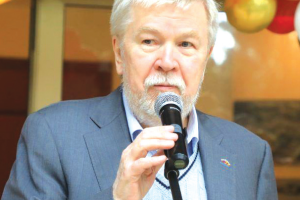
The wall picture was taken by night. In the foreground was a portion of a sea shore with tiny windows emitting light from high storey buildings. The scene was inside a cafe where a rectangular mirror reflects the picture and seemed to interact with the picture so as to take the viewer on a kaleidoscopic spectacle. In the real picture, the perspective was from below to the top whereas in the reflection it was from top to bottom.
The viewer seems to be traveling, in the first instance, in a boat and in the second, in an aircraft. An artificial light beam came directly form a ceiling falling on the man operating the coffee brewing machine. A few girls were serving customers both inside and outside the cafe. The cashier was a very beautiful girl wearing gigantic ear-rings.
She had taken her seat immediately after returning from a church. She went into the church from the Eastern Gate. Altogether there were three gates. The way upward was fairly steep. There were small shops along both sides of the road. A tailor was cutting cloth. A number of tin ovens weredisplayed for sale in one of the shops.
The compound was asphalted. One or two trees had protruded out of the pavement. The church had three doors. The eastern entrance was meant for women while the other entrance for priests and deacons. Opposite to the women`s entrance there was a door for men. She went directly to the door meant for women and bowed three times. She prayed but she did not feel like staying long inside the church.
After descending the asphalted road from the Eastern Gate and turning-left that took her to a gravel road, she came across a unique concrete bridge hardly allowing two persons to pass easily. She crossed the bridge.
She heard a one time popular tune and stopped to ascertain the words of the second stanza. Literally, the words spoken in Amharic were as follows: “Alber ende amora, sew argofetrognal (twice)-Anten batahu gize gira yegebagnal”. Translated, the message amounts to “I can’t fly like a bird, because I am a human-being. I feel at a loss as to what I should do whenever you are not with me!” Of course, it implies that if the singer, a lady, had the ability, she would have flown like a bird to meet the man she loved.
The song mentally transported her to her birthplace. She recalled how she left her father and mother in the early hours of the morning to meet him at the bus terminal. They arrived in Addis Ababa the second day. It was raining cats and dogs. They loved each other so much that the torrential rain meant nothing to them.
Most cities are paved with gold, but not for new comers like them. They were short of food. The money they had did not carry them long. They started to think that they had made a mistake.
She thought of her mother, her father and her sisters. Although she had been giving him all the comfort he needed, he could not think of anything but to go back to the place where he came from. He was disturbed by nightmares. At long last, he told himself that he would rather die than abandon her, and hoped things would change for the better.
A year latter he died of pneumonia. She wept and wept and wept.
She secured employment as a daily labourer to clean the city. She wore gigantic hats just as she is wearing now her gigantic ear-rings. Time passed. She loved another man.
She got married and had children. The family worked very hard, saved money, and ultimately succeeded in opening the new cafe where she is now doing business. At first she and her husband worked in shifts at day-time to keep the cafe running. Now she manages the cafe by herself while her husband kept himself engaged in another business.
Whenever new customers visited her cafe, they took her for an upstart, especially because she did not show off and still retained her girlish looks. She was mistaken for someone employed by a male boss. It was, as days go by, that the fact that she was her own boss dawned on them. The tragedy she had lived through never crossed their minds.
A reporter wanted to tell the story of her life to magazine readers and wondered where he could start. With a notebook in front of him and seeping coffee on one of the tables, he jotted down every detail from the beginning to the end. At the end, it amounted to nothing and he forgot all about it.
But another reporter became interested in the story and tried to discover “an angle” to it, as reporters often say when they think of turning a dreary story into a lively one. So, she took a bus to the birthplace of her subject and discovered her mother and father still alive and kicking well. She interviewed them one by one and, as it could be said of practically all reporters, she became sceptical of every fact she was told. Her scepticism reached a stage where she even doubted that the girl’s lover had died of pneumonia.
“Lovers don’t die; they live forever,” she said to herself, and with such a crazy idea in her mind, she carried out an investigation, though futile it appeared to many readers. After months of soul-searching analysis of each and every fact she got from all the people concerned, she discovered that the so called deceased had overcome the pneumonia and had ultimately survived.
The social bond that exists among those who have fled from the country and started life in cities is so strong that the chance of survival in fact, is much greater than actually assumed.
Leaving the hypothesis for sociologists to prove, the reporter assured herself that the young woman with gigantic ear-rings never lost her lover and that she probably might be living with him now. The assumption proved true beyond any shadow of doubt when the life of the cafe came to a sudden end, for a reason no one can tell, not to speak of the picture once serving as an advertisement for it.
THE ETHIOPIAN HERALD SUNDAY EDITION 25 AUGUST 2019
BY BERHANU TIBEBU ZEWOLDE





